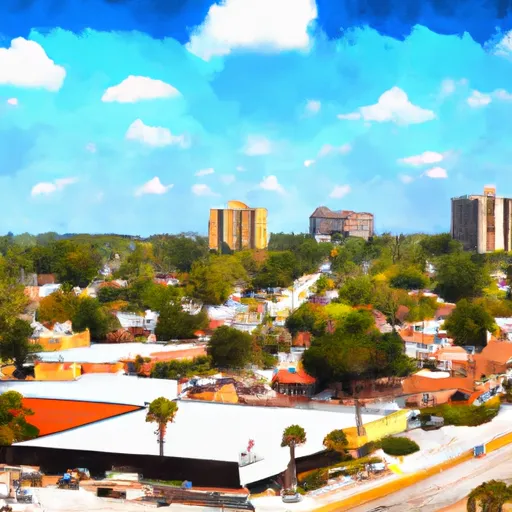-
 Snoflo Premium
Snoflo Premium
Get unlimited access to all our content
With no Ad interruptions! - Start Your Free Trial Login with existing account
Lee
Eden Index
Climate
7.7
•
Recreation
5.5
•
Community
0.8
•
Safeguard
5.2/10

Lee, Florida is a small town situated in Madison County. It experiences a humid subtropical climate, characterized by hot and humid summers with frequent afternoon thunderstorms, and mild winters with occasional cold snaps. Average temperatures range from the upper 60s to mid-90s (°F), making it suitable for outdoor activities throughout the year.
Hydrologically, Lee is positioned in close proximity to the Withlacoochee River, a major waterway in the region. This provides opportunities for various water-based recreation activities such as fishing, kayaking, and boating. The river is known for its diverse aquatic life and scenic beauty, attracting nature enthusiasts and anglers alike.
Apart from the river, the region offers additional outdoor recreation opportunities. Suwannee River State Park, located nearby, provides visitors with opportunities for hiking, camping, and picnicking. The park also boasts stunning views of the Suwannee River and offers access to the Florida Trail, a popular long-distance hiking trail.
Overall, Lee, Florida offers a favorable climate, abundant hydrological features, and diverse outdoor recreation opportunities, making it an attractive destination for nature lovers and adventure seekers.
What is the Eden Index?
The Snoflo Eden Index serves as a comprehensive rating system for regions, evaluating their desirability through a holistic assessment of climate health, outdoor recreation opportunities, and natural disaster risk, acknowledging the profound impact of these factors on livability and well-being.
Climate Health Indicator (CHI): 7.7
Lee receives approximately
1323mm of rain per year,
with humidity levels near 87%
and air temperatures averaging around
20°C.
Lee has a plant hardyness factor of
8, meaning
plants and agriculture in this region tend to thrive here all year round.
By considering the ideal temperature range, reliable water supplies, clean air, and stable seasonal rain or snowpacks, the Climate Health Indicator (CHI) underscores the significance of a healthy climate as the foundation for quality living.
A healthy climate is paramount for ensuring a high quality of life and livability in a region, fostering both physical well-being and environmental harmony. This can be characterized by ideal temperatures, reliable access to water supplies, clean air, and consistent seasonal rain or snowpacks.
Weather Forecast
Streamflow Conditions
Suwannee
Area Rivers
Suwannee
Snowpack Depths
Suwannee
Reservoir Storage Capacity
Suwannee
Groundwater Levels
Recreational Opportunity Index (ROI): 5.5
The Recreational Opportunity Index (ROI) recognizes the value of outdoor recreational options, such as parks, hiking trails, camping sites, and fishing spots, while acknowledging that climate plays a pivotal role in ensuring the comfort and consistency of these experiences.
Access to outdoor recreational opportunities, encompassing activities such as parks, hiking, camping, and fishing, is crucial for overall well-being, and the climate plays a pivotal role in enabling and enhancing these experiences, ensuring that individuals can engage in nature-based activities comfortably and consistently.
Camping Areas
| Campground | Campsites | Reservations | Toilets | Showers | Elevation |
|---|---|---|---|---|---|
| Suwannee River State Park | None | 74 ft | |||
| Paulk City Park | 25 | 335 ft | |||
| Horseshoe Beach County Park | None | 9 ft | |||
| Shell Mound County Park | None | 7 ft | |||
| Gibson | None | 65 ft | |||
| Grassy Pond Military | None | 171 ft | |||
| Shired Creek County Park | None | 11 ft |
Catastrophe Safeguard Index (CSI):
The Catastrophe Safeguard Index (CSI) recognizes that natural disaster risk, encompassing floods, fires, hurricanes, and tornadoes, can drastically affect safety and the overall appeal of an area.
The level of natural disaster risk in a region significantly affects safety and the overall livability, with climate change amplifying these risks by potentially increasing the frequency and intensity of events like floods, fires, hurricanes, and tornadoes, thereby posing substantial challenges to community resilience and well-being.
Community Resilience Indicator (CRI): 0.8
The Community Resilience Indicator (CRI) recognizes that education, healthcare, and socioeconomics are crucial to the well-being of a region. The CRI acknowledges the profound impact of these elements on residents' overall quality of life. By evaluating educational resources, healthcare accessibility, and economic inclusivity, the index captures the essential aspects that contribute to a thriving community, fostering resident satisfaction, equity, and social cohesion.

